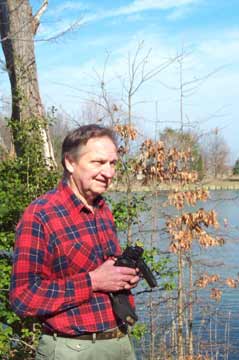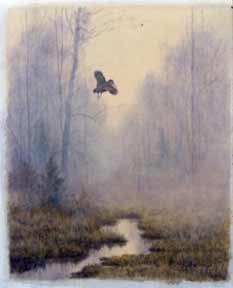|
|
 |
“I want to penetrate the obvious, to capture the uniqueness of each locale. I want to know something about the ecology of the area, to recognize and understand its plant and animal life.”
photo by Sonia Linebaugh
|
John W. Taylor
by Sonia Linebaugh
“I wonder how much people are affected by art?” John Taylor asked at the ceremony honoring him with the 2002 Jug Bay Award, presented annually to a person who furthers the goals of environmental education and wildlife and habitat preservation in the Jug Bay area of the Patuxent River.
“Can my work really help the cause of conservation?” the Edgewater artist wondered.
Friends of Jug Bay clearly think so. Their award honors not only Taylor’s past service on their board and his work banding birds, but especially his donation of the copyrights to two paintings. One shows a great blue heron characteristically poised to hunt. The other is a successful osprey showing off a plump catfish.
Others who have been seduced by his quiet marsh-scapes and bird portraits agree that Taylor’s work influences environmental thinking. Among them are the wildlife lovers who’ve bought the posters created from Taylor’s paintings to bring in funds for conservation and habitat improvements at Jug Bay.
That’s help the Anne Arundel County sanctuary needs now more than ever. With the addition of the 615 acres of the Glendening Preserve to Jug Bay Wetlands Sanctuary last October, the three-preserve complex — including Patuxent River Park and Merkle Wildlife Sanctuary on the Prince George’s side of the Patuxent — has become the largest tidewater park within 50 miles of Washington and Baltimore. Seven thousand three hundred and fifteen acres is a lot of habitat to conserve.
“People ask me whether I’m an artist or naturalist,” says John Taylor, who friends call Bud. “I tell them that when it comes time to cash in my chips, I’ll feel bad about the pictures I didn’t paint, not about the birds I didn’t see.”
Taylor has tramped and canoed most of the Bay’s shorelines, marshes, creeks and rivers while studying its birds over five decades. Images brought home from his adventures become paintings in his studio on Pennington Pond, on the South River side of the Mayo peninsula.
“I get started from slides,” Taylor tells me. “I use them as you would sketches, combining information from as many as four or five slides to make a painting. Out in the marshes, the wind is blowing or the sky will change every few minutes.
“The camera is no substitute for the human eye,” Taylor explains, “so I wouldn’t use someone else’s photos. If I hadn’t been at that spot, the photos wouldn’t mean anything.”
This quiet passion for art is a continuous thread in Taylor’s life, but it started with the birds. The Junior Audubon Club of fourth grade made a big impression. Later, in his teens, his mother drove him out from Washington, D.C., up around the top of the Bay — in those days before the Bay Bridge — to the Sassafras River to join his first birding expedition on the Chesapeake. Taylor made 36 birding trips in that year of 1950 and still has the time-worn journal to prove it, pages of neat tiny printing decorated with stamp-sized silhouettes of birds.
 |
| © painting reproduced courtesy of John W. Taylor |
By the time he graduated into the world of work, Taylor knew enough about birds to be hired by the Smithsonian.
“It was a menial job,” he says. “I opened packages of dead stuffed birds, put identifying tags on them and put them into the correct drawer. The hard ones were identified by the staff experts.”
The plus was that Taylor got to meet many artists. They came in to paint from the specimens or to paint the backgrounds for bird displays. He was especially impressed by the artists who put feeling into their work. To this day, Taylor’s paintings are characterized by a mood of tranquillity
“I do stormy moods,” he allows, “but I like tranquil better.”
When Taylor got drafted into the army in the Korean War era, he was stationed in Germany. There he pursued his twin passions. He sought out bird artists, joined a German bird club and wandered Europe with nothing but a satchel on his back. He visited artist D.M. Henry in a poor section of London and, with kids crying underfoot, got a personal drawing lesson, which he still has tucked into a book of Henry’s illustrations.
Bird art didn’t seem to pay for Henry. Taylor, too, concedes that it can be tough going. “I led a very frugal life for a long time. The bird stamps were remunerative, the first real money I made.”
He’s talking about his competition-winning art for Maryland’s first Waterfowl Stamp in 1974, and numerous awards since, including the 1979 Maryland and 1984 Florida State Duck Stamp design competitions. Taylor has also designed five non-game conservation stamps.
Jug Bay came into his ken in the 1960s, when it was private land. “I’m the world’s biggest trespasser,” he notes. “A no-trespassing sign means good birding to me. Nowadays people chase you off, but it used to be that the landowners were as interested as you in what you might find.”
“Back then,” he continues, “a man lived there with his wife and kids in a house near the present visitors center. The husband was a cab driver in Washington and a duck hunter at home. He’d charge people to act as their bird guide. Later on, the family moved away but the boys still hunted there. Once they had a whole pile of rail birds they had shot. That was before bag limits.” Taylor gave them prints of his work so he could keep trespassing.
Now he doesn’t have to trespass. He’s welcome at Jug Bay any time, but the environment has changed.
“There used to be huge flocks of waterfowl in the 1960s and before. That’s all gone now.”
Maybe his paintings can help change that.
Birds were Taylor’s first subject and they remain dear to his heart. But Taylor’s latest paintings, like Jug Bay, have something less about them. The birds are gone. That’s not a statement about the environment, Taylor insists.
“I did the portraits of birds so they could be identified,” he says. “I’ve also done birds in the landscape. Now I’m making landscapes without birds. Putting a bird in makes the painting into a frozen moment in time. When there’s no bird, you have more of the timeless essence of a scene.
“I cannot just sit down in some strange part of the world and paint whatever is there before me,” Taylor explains. “I want to penetrate the obvious, to capture the uniqueness of each locale. I want to know something about the ecology of the area, to recognize and understand its plant and animal life.”
That seems the crux of the matter for him: understanding the relationships of nature. You can hear it in his speaking and see it in the paintings: the timeless essence of things.
“I feel” he says, “that I am only now attaining a mature understanding and appreciation of this one little corner of the planet.”
His paintings help others see the same way.
See John W. Taylor’s evocative work at Ward Museum of Wildfowl Art in Salisbury where his paintings are on display through March 31. Closer to home, see his paintings in May at the new Ollie Miller Gallery in the old Lothian post office on Route 2 just north of Southern Anne Arundel County’s only traffic circle. Weekend hours: 410/867-6166.
Or look into Taylor’s two books, Birds of the Chesapeake Bay, just out in a new printing, and Chesapeake Spring. A book of Bay Country landscapes is in planning.
Copyright 2002
Bay Weekly
|